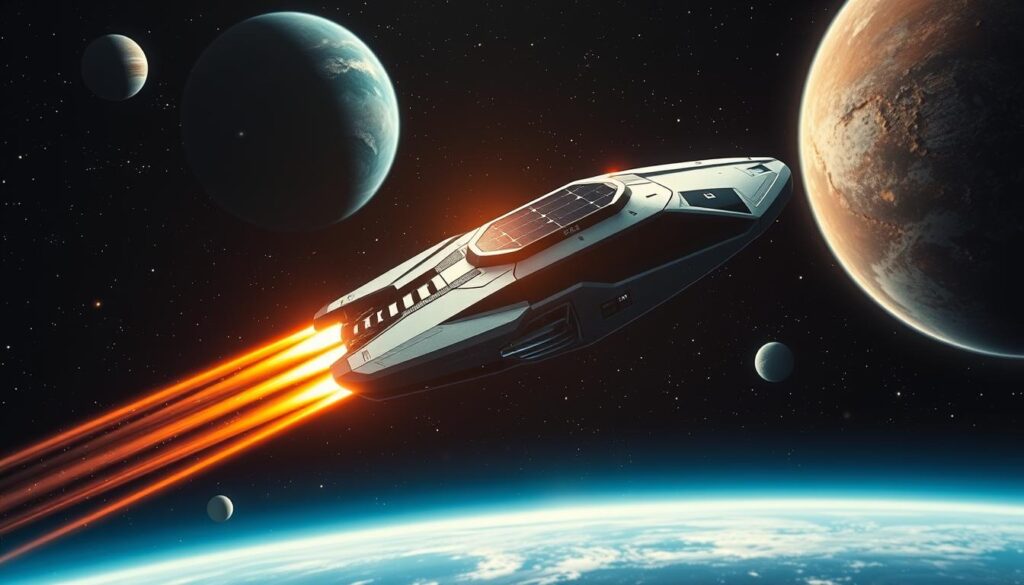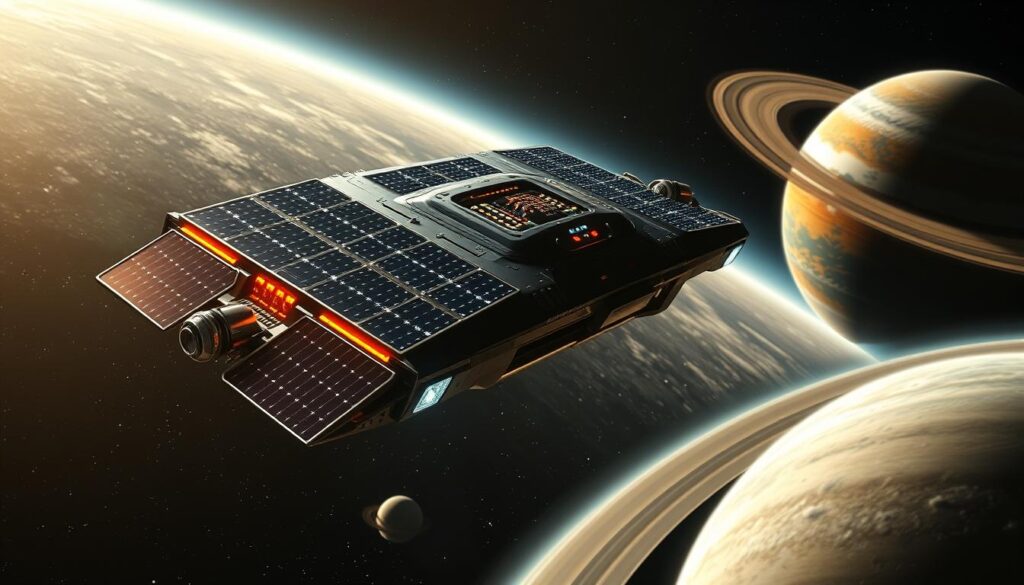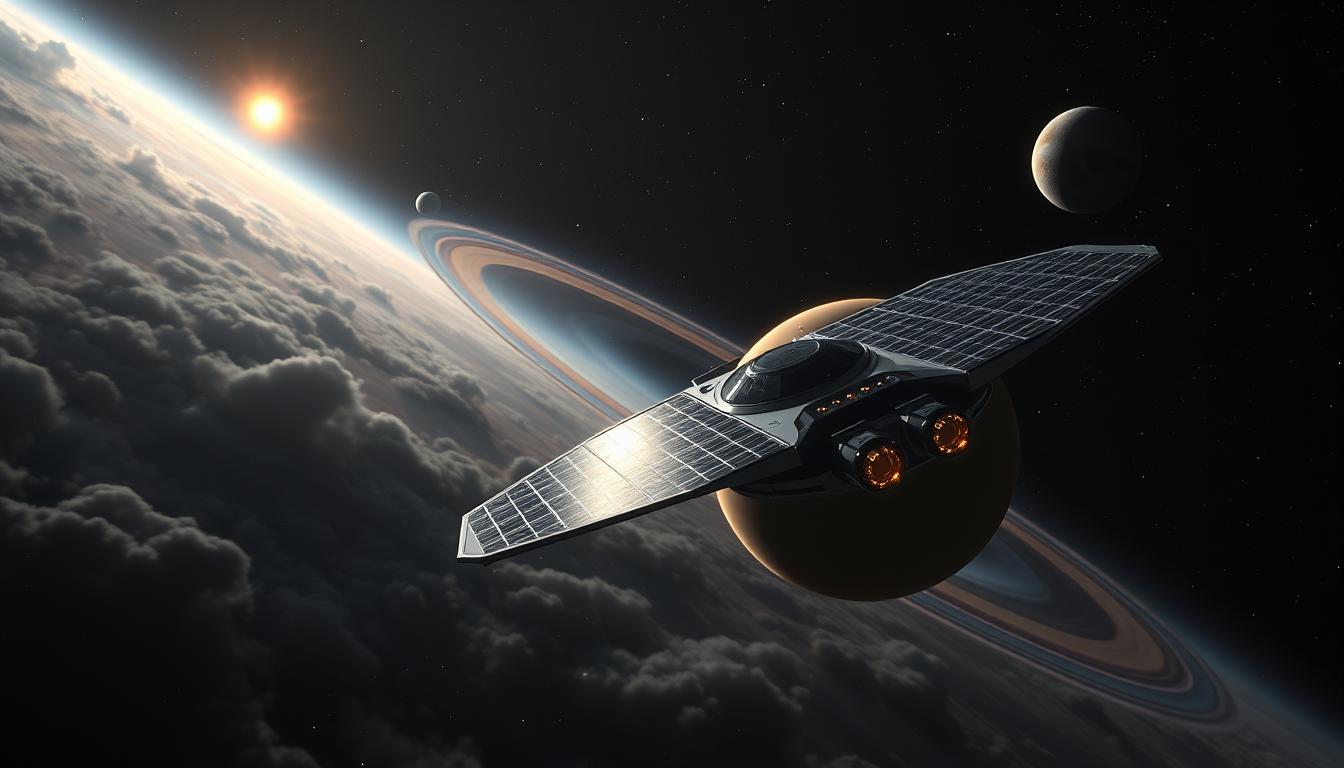Have you ever looked up at the stars and wondered about the brave spaceships that explore the universe? I’ve always been amazed by how we power these daring explorers. But here’s a mystery: which spacecraft was the first to use the sun’s energy to reach the outer planets?
This question might make you think differently about what’s possible in space technology.
Nine brave spacecraft have traveled to Jupiter and beyond. But only three have made it to orbit around these planets. As I dug into space history, I found a mission that changed how we power long-distance space travel.
Key Takeaways
- Nine spacecraft have ventured to explore the outer planets
- Only three missions have successfully orbited outer planets
- Solar power has emerged as a game-changer in space exploration
- Juno stands out as a pioneer in solar-powered outer planet missions
- Advancements in space technology continue to push the boundaries of exploration
The Dawn of Solar-Powered Space Exploration
I’ve always been fascinated by how space power systems have evolved. From the start of space travel to today’s advanced missions, powering spacecraft has been a big challenge.
Early challenges in powering spacecraft
At first, space agencies used radioisotope thermoelectric generators (RTGs) for deep space missions. These devices turn heat from radioactive decay into electricity. They provided power for years but had limits in lifespan and power.
The shift towards solar energy in space
As technology improved, solar panels in space became a better choice. Solar power is renewable and can last decades. But, there were challenges like less sunlight in deep space and needing bigger panels.
Advantages of solar power for long-distance missions
Solar-powered spacecraft have big advantages over RTGs. They’re safer to launch, better for the environment, and can provide more power for longer. Plus, better solar cell efficiency makes them good for missions to the outer planets.
| Power Source | Advantages | Disadvantages |
|---|---|---|
| RTGs | Constant power output, long lifespan | Limited power, radioactive hazards |
| Solar Panels | Renewable energy, potentially higher power output | Reduced efficiency in deep space, larger size required |
The success of solar-powered missions like Juno shows they can work in the outer solar system. It’s an exciting time for space exploration. I’m looking forward to what future solar-powered missions will do.
Pioneering Missions to the Outer Planets
I’m excited to explore the outer planets with you! The Pioneer missions and Voyager program were our first steps into the unknown. They opened doors to new discoveries and left a lasting impact on space history.

In the early 1970s, Pioneer 10 and 11 led the way. They were the first to cross Mars and enter the asteroid belt. These brave explorers didn’t stop there. They flew by Jupiter and even visited Saturn with Pioneer 11.
The Voyager program took it to the next level. Voyager 1 and 2 visited Jupiter and Saturn. Voyager 2 went even further, exploring Uranus and Neptune.
“The Voyager missions were like sending a message in a bottle into the cosmic ocean. We never knew what we might find.” – Carl Sagan
These missions used RTGs for power, essential for the outer solar system. Their findings changed how we see gas giants and their moons. They set the stage for more exploration.
Thinking about these missions, I’m amazed by the scientists and engineers. They showed true courage and creativity. Their work inspires us all to explore and discover more.
The Race to Explore Jupiter and Beyond
I’ve always been fascinated by the gas giant planets in our solar system. Exploring these distant worlds has been incredible. Let’s look at some exciting missions that have helped us understand Jupiter and Saturn.
Pioneer and Voyager Missions
The Pioneer 10 spacecraft started Jupiter exploration in 1973 with a historic flyby. But the Voyager missions really caught my attention. They gave us amazing pictures and data about Jupiter’s clouds and Saturn’s rings.
Galileo’s Groundbreaking Jupiter Orbit
In 1995, Galileo became the first spacecraft to orbit Jupiter. I was glued to my TV as it dove into Jupiter’s clouds. This mission changed how we see the gas giant and its moons.
Cassini-Huygens and the Wonders of Saturn
The Cassini-Huygens mission took Saturn exploration to new levels. From 2004 to 2017, Cassini orbited Saturn, revealing secrets about its moons and rings. The Huygens probe even landed on Titan in 2005, showing us its surface.
| Mission | Target | Key Achievement |
|---|---|---|
| Pioneer 10 | Jupiter | First Jupiter flyby |
| Voyager | Jupiter and Saturn | Detailed imagery of both planets |
| Galileo | Jupiter | First Jupiter orbiter and atmospheric probe |
| Cassini-Huygens | Saturn | Extensive Saturn system study and Titan landing |
These missions have changed how we see gas giant planets. They’ve shown us Jupiter’s storms and Saturn’s rings. They’ve also sparked our curiosity for more exploration of these distant worlds.
Which spacecraft was the first sent to the outer planets powered by solar
I’m excited to share the groundbreaking story of the Juno spacecraft. It was NASA’s first solar-powered mission to explore the outer planets. Launched on August 5, 2011, Juno embarked on an ambitious journey to Jupiter, pushing the boundaries of space technology.

The Juno spacecraft made history on July 4, 2016, when it entered Jupiter’s orbit. This milestone marked a new era in NASA outer planet exploration. It proved that solar power could fuel missions to distant worlds.
Let’s take a closer look at Juno’s impressive stats:
| Characteristic | Details |
|---|---|
| Launch Date | August 5, 2011 |
| Arrival at Jupiter | July 4, 2016 |
| Power Source | Solar panels |
| Solar Panel Size | 60 square meters |
| Mission Duration | Extended until September 2025 |
Juno’s success has paved the way for future solar-powered Jupiter missions. Its innovative design allows it to operate nearly 500 million miles from the Sun. There, sunlight is 25 times weaker than on Earth. Talk about a solar-powered marvel!
As I reflect on Juno’s achievements, I’m in awe. Juno has revolutionized our approach to exploring the outer reaches of our solar system. It’s a testament to human ingenuity and our relentless pursuit of knowledge about our cosmic neighborhood.
Juno: A Solar-Powered Marvel at Jupiter
I’m always amazed by the ingenuity of space exploration, and Juno is a prime example. This spacecraft has revolutionized our understanding of Jupiter, all while relying on the power of the sun. Let’s dive into what makes Juno so special.
Unique Design and Capabilities
Juno’s design is a testament to human innovation. Its three massive solar arrays span 20 meters, capturing precious sunlight at Jupiter’s great distance from the Sun. These arrays are key to fulfilling Juno mission objectives, providing power for its suite of advanced instruments.
Overcoming Solar Power Challenges
Powering a spacecraft at Jupiter’s orbit is no easy feat. The solar energy available there is just 4% of what we get on Earth. To tackle this, Juno’s team optimized its orbit and mission profile. The result? An impressive solar array efficiency that keeps Juno running strong, even in Jupiter’s harsh environment.
Groundbreaking Discoveries
Juno has peeled back the layers of Jupiter’s mysteries. It’s revealed secrets about the planet’s atmosphere, magnetic field, and internal structure. I’ve been fascinated by its findings on Jupiter’s atmosphere, including the depth of the Great Red Spot and the presence of “shallow lightning” in the upper atmosphere.
- Mapped Jupiter’s magnetic field
- Discovered cyclones at the poles
- Revealed details about Jupiter’s core
Juno’s success proves that solar power can drive exploration of our outer solar system. It’s opened new possibilities for future missions, showing us that with the right design and determination, we can reach further into space than ever before.
The Impact of Solar Power on Deep Space Exploration
I’ve seen a big change in space travel, thanks to the sun. Space solar technology has changed how we explore space. We no longer just use nuclear power for deep space trips. Now, we can explore space in a way that’s both possible and good for our planet.
Spacecraft like Juno have shown us what’s possible. We’re planning missions that will last longer and go further. It’s thrilling to think about all the new places we can explore in our solar system.
“Solar power is the key to unlocking the secrets of our outer planets.”
Here’s how solar power is changing deep space missions:
- Longer mission durations
- Reduced reliance on limited nuclear fuel
- Lower mission costs
- Decreased environmental concerns
This change is huge. We’re starting a new era of space exploration that’s both bigger and better for our planet. It’s great for science and for taking care of our environment.
| Aspect | Traditional Power | Solar Power |
|---|---|---|
| Mission Duration | Limited by fuel | Extended |
| Environmental Impact | Higher | Lower |
| Cost | Higher | Lower over time |
| Future Potential | Limited | Expanding |
As we keep improving space solar technology, the future of space exploration is looking up. I’m excited to see where our solar-powered journey will take us next.
Future Solar-Powered Missions to the Outer Planets
I’m excited to talk about the future of space travel. New missions are coming that will change how we see the outer planets and their moons.
Upcoming Missions and Their Objectives
Two big missions are coming. The Europa Clipper, from NASA, will explore Jupiter’s moon Europa. This moon might have water under its ice, which could mean life.
The European Space Agency’s JUICE mission will also explore Jupiter’s moons. It will study Ganymede, Callisto, and Europa. JUICE will help us learn if life can exist in these cold places.

Advancements in Solar Technology for Space Exploration
New solar cells are key for these missions. They work better and last longer, letting spacecraft go farther from the Sun. The progress in solar technology is incredible!
| Mission | Target | Launch Year | Solar Array Size |
|---|---|---|---|
| Europa Clipper | Jupiter’s moon Europa | 2024 | 100 m² |
| JUICE | Jupiter’s icy moons | 2023 | 85 m² |
These missions mark a new era in space travel. Solar power is leading the way, and we’re about to discover more about our universe than ever before.
Comparing Solar Power to Traditional Space Power Sources
I’ve always been fascinated by the power sources that drive our exploration of the cosmos. When it comes to space power efficiency, we’re faced with a choice between two main contenders: solar panels and Radioisotope Thermoelectric Generators (RTGs). Let’s dive into this cosmic power struggle!
Solar panels have come a long way in space exploration. They’re renewable, lightweight, and perfect for missions close to the Sun. But as we venture further out, their efficiency drops dramatically. That’s where RTGs shine – these nuclear power workhorses keep chugging along regardless of their distance from our star.
| Feature | Solar Panels | RTGs |
|---|---|---|
| Power Source | Sunlight | Radioactive decay |
| Efficiency in Deep Space | Decreases with distance | Consistent |
| Lifespan | 20+ years | Limited by fuel half-life |
| Weight | Lighter | Heavier |
| Best Use | Inner solar system missions | Outer planet exploration |
Choosing between RTGs vs solar panels isn’t just about power output. It’s a delicate balance of mission duration, distance, and energy needs. As we push the boundaries of space exploration, we might even see hybrid systems that combine the best of both worlds!
Conclusion
I’ve taken you on a journey through the stars, and what a ride it’s been! Juno’s mission to Jupiter has changed the game for solar power in space. This spacecraft showed us we can use the sun’s energy even far from Earth.
The future of space exploration is looking bright. Juno is leading the way to more sustainable power for deep space missions. It’s like a sci-fi movie, but it’s real!
As we keep discovering new planets, I get more excited. Will we see solar-powered probes around Saturn’s rings or in Neptune’s storms? The possibilities are endless, and I’m eagerly waiting to see what solar power brings to space.
FAQ
What was the first solar-powered spacecraft sent to explore the outer planets?
What were the early challenges in powering spacecraft for deep space exploration?
What are the advantages of using solar power for long-distance space missions?
Which pioneering missions paved the way for outer planet exploration?
What were some of the key milestones in exploring Jupiter and Saturn?
What unique design and capabilities did Juno have for its solar-powered mission to Jupiter?
How has Juno’s success impacted the future of deep space exploration?
What are some upcoming solar-powered missions and advancements in solar technology for space exploration?
What are the pros and cons of solar power compared to traditional space power sources like RTGs?
Source Links
- List of missions to the outer planets – https://en.wikipedia.org/wiki/List_of_missions_to_the_outer_planets
- Voyager 1 – NASA Science – https://science.nasa.gov/mission/voyager/voyager-1/
- Probes to the Outer Planets – https://historicspacecraft.com/Probes_Outer_Planets.html




Interesting read but isnt it odd that were still stuck on solar power? Shouldnt we be exploring nuclear or even quantum energy by now?
Interesting stuff, but honestly, wouldnt nuclear power be more reliable for outer planets? Solar seems risky with less sunlight. Just a thought 🤷♂️.
Isnt it amazing how far weve come? Just think, the first solar-powered spacecraft was considered sci-fi not too long ago!
Indeed, its fascinating! Makes you wonder what sci-fi today will be reality tomorrow.
Isnt it amazing how far weve come? Solar powered spacecrafts, who wouldve thought! Now, when do we get solar powered cars mainstream?
Mainstream solar cars? When we value planet over profit. Wake up, theyre not in a rush.